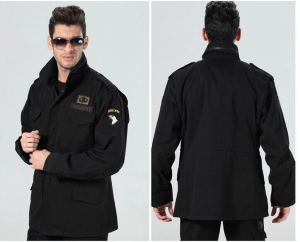Dress Your Field Service Techs for the Cold Weather
There’s a good chance your field service techs will never show up to client sites looking like this:

… because, well, that’s both unsafe and unprofessional, and usually you don’t want to begin a job with two strikes against you. We’ve already delved into the trendy world of field service attire, so you can consult that post for some examples of what’s hot (and what’s not!) on service calls these days. The winter is a different animal, though. Main reason: It’s cold. (Hopefully you knew that.) Other factors: ice, sleet, wind, etc. If you live in southern California, please stop reading this post now.
But come on, you need to dress your techs for the cold weather. Here’s an example:

While that jacket does look a bit like it could have appeared on a bad guy from a 1980s cop show, it will keep your technicians warm on service calls. And that’s the whole point here.
Here’s another example. This is meant as a military jacket, but the same premise will work in field service:

Nice bonus: It’s impossible to tell if this man is angry or happy. Look at the photo for a while. You will have the same challenge.
An important non-fashion aspect is driving. In many local markets, road conditions will be worse in the winter. Your field service tech efficiency, is going to be at an all time low when driving in bad situations. If you know that certain areas are particularly bad (a street prone to icing, etc.), input into your FSM software to avoid that street when routing and dispatching technicians. If you’re already using route scheduling software, this is a simple adjustment. Within most field service management software platforms, though, it won’t be complicated to set up. If your technicians use Waze or another traffic guidance app, there are usually features involving weather’s interaction with different streets.
There are some days in any winter that are just awful because of the cold, wind, ice, etc. You can take two different approaches to these days. (1) is business as usual, which many FSOs do. (2) is calling the customers for those days and asking if you can adjust to tomorrow. Offer them something — maybe a 10 percent drop or whatever else you think is fair. Some customers will demand you come that day; if so, get out there and help them with their issues. Most will allow you to defer because there’s a good chance no one else is coming on-site with them either.
This is important because sending technicians on five to six jobs on an awful winter weather day can be dangerous — and it’s extremely taxing for the technicians. If it’s a really bad winter and they are consistently having to do this, there’s a good chance frustration is building. Frustration can lead to turnover, and too much turnover destroys a small business FSO.
Another advantage: These thick jackets and other winter wear can be branded with your company logo, which helps with marketing, a big issue in small business field service, and generally gets more people in your local market to know your name and remember you. Branding is a cost-effective way for field service businesses to get their names out into a community. (Jackets for 10-20 technicians won’t usually run more than $500 or so.) And if you’re still looking for a holiday gift for your techs, this may be the one.
We put together a book on reducing turnover without spending any money (yay) and one of the hallmarks is respect for your technicians. You cannot control the weather, no, but you can control how you approach customers and your own employees on extreme weather days. That respect for both sides needs to be maximized — customers need to feel like their needs are being addressed, obviously, but so do employees. (A lot of us miss this crucial point.)
If you’d like to learn more about reducing turnover, download the book now. And hey — stay warm out there.


